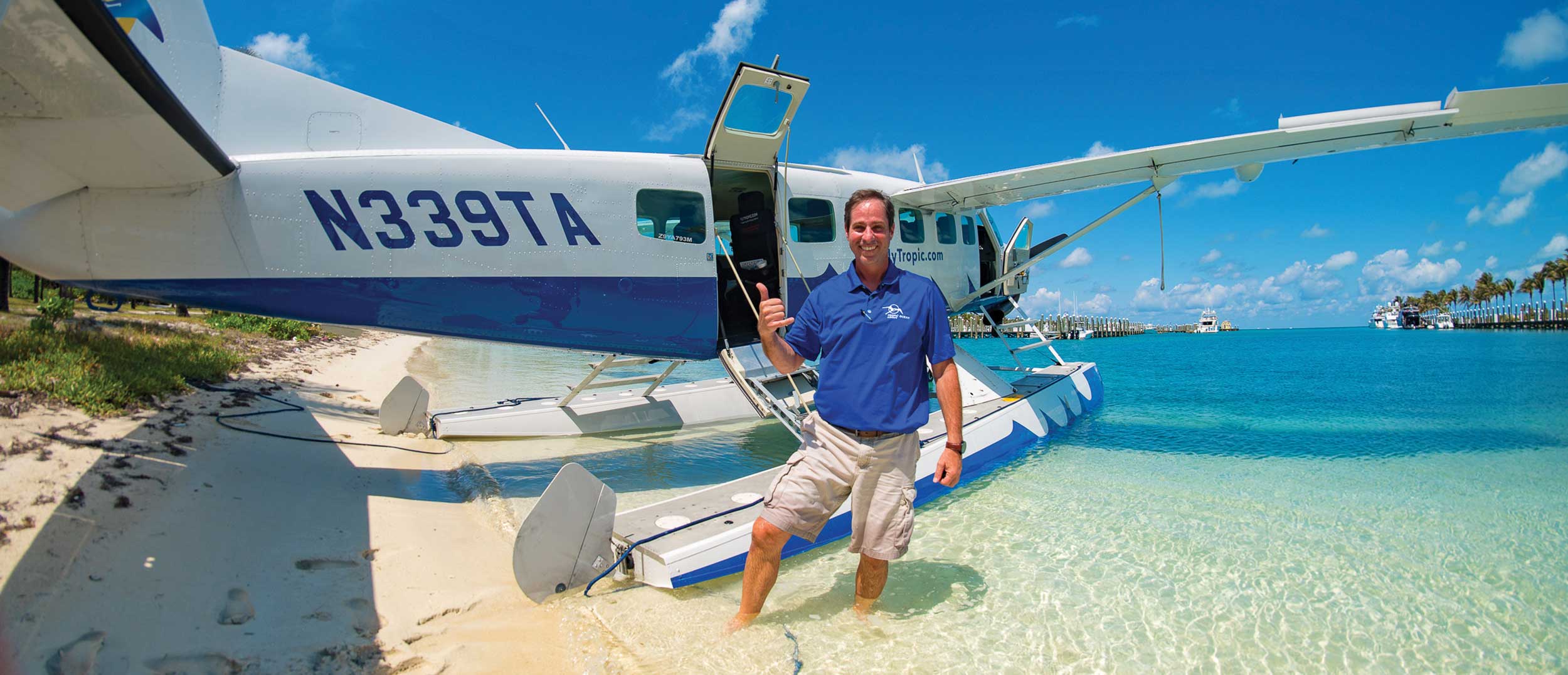 I Get Paid for This…
I Get Paid for This…
This article first appeared in FLYER in December 2018
From landing on Manhattan’s spectacular East River to island-hopping in the Caribbean, no wonder this seaplane pilot loves his job…
Interview by Yayeri van Baarsen
How did you get into flying?
Whenever my dad would fly for business, our family would see him off at Cape Town Airport and those visits made such an impression – I even remember drawing it in nursery school.
Aged six, aeroplanes already fascinated me – I wondered what it’d be like to soar in the sky like a bird.
Tell us about your job…
I’m a seaplane pilot for a Florida-based airline, flying a Grand Caravan Amphibian in the Bahamas. I really like the diversity – flying to the islands, we visit fancy marinas, luxury yachts, private beaches and protected bays.
However, this summer I was on assignment in New York, flying people from Manhattan to their holiday homes, on the eastern side of Long Island, for the weekend.
Commuting back on Monday morning, the passengers were in suits and ties so we’d pull out our red-carpeted ramp so they didn’t have to walk on sand.
What makes flying in NYC so good is that it’s challenging, not only because of Manhattan’s many bridges, but also as we’d take-off and land on the East River.
It’s the roughest, trickiest body of water to operate a seaplane on – full of waves and currents, with boats and ferries crossing at all times.
Floating debris, like tree trunks, also adds to the difficulty factor, as hitting one can seriously damage your seaplane.
With three major airports in the proximity, NYC’s airspace is the world’s most crowded. The ATC comms are insane, both in terms of volume and speed, so you have to be on top of your game.
Another challenge is the weather, as often you’re landing in dense fog. All-in-all it was a very heavy workload and a constant test of my abilities, which I liked.
Scenery-wise, I definitely prefer flying in the Caribbean. When we have time between flights, we tie up the seaplane and go for a snorkel, which is like jumping into a fish pond.
The sensation of landing on crystal-clear water is incredible – you see the marine life long before touchdown. As the ocean is our runway, we can fly at 1,500ft, which makes for great views.
The C208’s cockpit is open to the cabin, which allows for interaction with the passengers, who are always in a good mood as they’re on holiday – often, we’ll do a flyover of where they’re staying.
Every day, I wake up wanting to fly – my job feels like a paid holiday!
What training did you have?
I did my early training in Africa, but moved to the US as I wanted to fly and travel more, and I then earned my FAA credentials and CPL.
In the early 2000s I became aware of bush flying, and a trip to Alaska confirmed that piloting seaplanes offers the most fun and adventure.
I trained for my seaplane rating in Alaska, Seattle and Florida.
What’s been your favourite flight?
Ferrying a Cessna C206 from Anchorage to California in 2016. I gained a lot of seaplane experience, as we spent two weeks exploring the Alaskan coast, flying into fjords and glacier bays.
It was incredible, a visual overload of stunning scenery. Going off-grid was also challenging and technically difficult, as flying in such a remote area required survival-planning and lots of prep. It was a total outdoor adventure.
And your favourite airfield?
At Sitka, a sleepy Alaskan fishing village only accessible by air and boat.
The runway’s edges go right into the water and on approach you fly over a bay dotted with little islands which, if it weren’t for the snowcapped mountains, gives the impression that you’re flying in the Caribbean.
Do you get to fly much outside work?
Not as much as I’d like. I’ve a helicopter PPL and did some heli flying as a hobby, but it’s prohibitively expensive so now I mostly fly fixed-wing types.
Occasionally, I go seaplane flying in Alaska with friends, and picnic in fun locations, but my schedule was fairly full this year, and it was difficult to get to remote places from NYC during my two days off.
What’s the most valuable career advice you’ve received?
My PPL examiner said, “After every flight, ask yourself two things: Did you have fun, and did you learn something? If you can’t answer ‘yes’ to both questions, something’s wrong and you’ll have to change, whether that means going back to the books and/or adjusting something. Never become complacent.”
That advice stuck with me and I still apply it religiously as I think it captures the essence of successful flying.
Flying CV
Deon Mitton flies scheduled seaplane operations, tours and charters in the Bahamas, but was on assignment in NYC this summer.
Started work January 2018
Now flying Cessna C208 Grand Caravan Amphibian
Favourite De Havilland Beaver seaplane
Hours at job start 600
Hours now 1,000